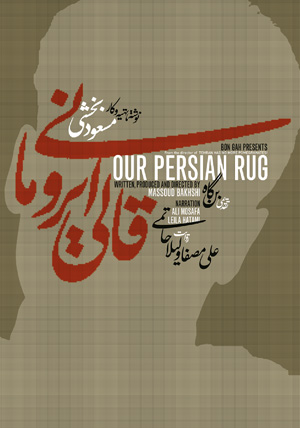|
|
| Welcome to Online Film Home! |
|---|
|
|
Our Persian Rug | Ghaali-e Irooni-e Ma (2010)
|
Synopsis
The perplexing memories of a young man who can't forget his past. At the center of this family history is a Persian rug that his grandmother once wove.
Staring at this rug, he obsessively leafs through photo albums to see which of his family members are lying and which ones are telling the truth. In either case, no one is talking.

Writer,Producer,Director: Massoud Bakhshi
Photography: M.Bakhshi, Mahmoud Mahrumi
Editing: Alimohammad Ghasemi
Sound: Behrouz Shahamat
Designer: Reza Abedini
Narrators: Ali Mosafa, Leila Hatami
Produced by: Bon Gah
Festivals
World Premiere - IDFA 2010
*****
Massoud Bakhshi’s film is a rug that never stops unrolling. The narrator, supposedly the director himself, has been stuck in his room since his father’s death two and a half years ago.
The confined space becomes a pretext for an experimental piece of storytelling which turns the rug - a family heirloom - into a magic lamp for the past.
However, the method of narration used questions the film’s own ability to recall this past.
A void has to be filled. The father is dead; only the treacherous uncle who tried to take possession of his brother’s life and wife remains.
The narrator’s world limits are the walls of his tiny, abyssal room in which everything looks gigantic when you have taken sleeping pills for mentally-ill people. Objects awake memories: the clock turns back the hands of the time and plunges the viewer into the family album.
Photos two generations old and archive footage illustrate a story told by an unstoppable voiceover. The viewer gets to know everything about the rise and decline of this Iranian family, which grew rich thanks to the rug trade. The son and the deceased grandmother engage in a dialogue over the pictures, which themselves ineluctably remain silent.
Stop-motion sequences hold back the continuity of the memories, which can only be apprehended in fragments. The story is a big movie that has shattered with the passing of time, and which the director tries to recover through verbal means.
But this omnipresence of speech only points to the failure of the images in reviving the past, without giving it more consistency.
The chore of the narration is the rug made by the narrator’s grandmother. The family tree is its pattern, a huge brain containing all the memories. The rug gave the past back to the narrator, and it is also the place where the daughters of the deceased brothers and sisters play.
At the same time past and future, the rug is a mausoleum where the past can be told to be forgotten and allow the next generations to come.
The retrospective of pictures stops with the arrival of the girls, injecting a new temporality into the narrative. Continuity can be thought again.
But then the narrative voice is abandoned for the images, which seem to be only efficient in the present tense. The film has failed in its attempt to reconstitute the past and the void is filled with the present.
In the end, the rug is rolled up again and given back to the uncle guilty of having stolen the family past. Texts and textile are given up for the video texture.
The present can live again through the passivity of a look, with no need for narration.
By Viviane Saglier
|
|

About this movie
Title: Our Persian Rug | Ghaali-e Irooni-e Ma (2010)
Directed by: Massoud Bakshi
Date of birth: 1972, Teheran, Iran
Writing credits: Massoud Bakshi
Year: 2010
Country: Iran
Language: Farsi
Color: Black and White | Color
Runtime: 49 mins
Search
|
|
|
|
|

Cannes 2024 |
Choose an item to go there!
|
| |
|
|

